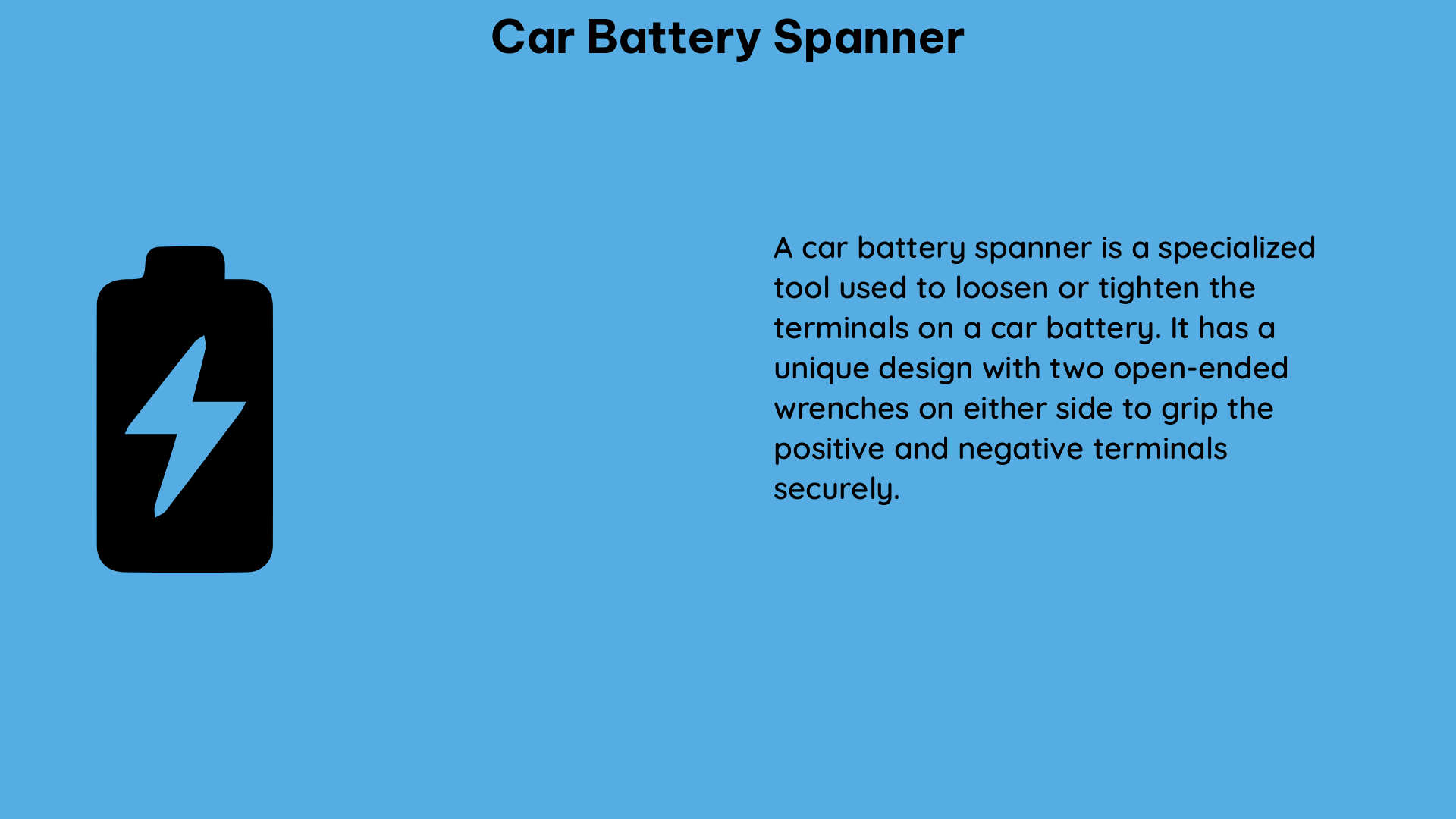The car battery spanner, also known as a wrench, is a crucial tool for maintaining your vehicle’s electrical system. Its primary function is to tighten or loosen the battery terminals, ensuring a secure connection and minimizing the chances of loose connections that could lead to electrical issues.
Understanding the Measurement Systems for Car Battery Spanners
When selecting the right size wrench for your car battery, it’s essential to consider the measurement system used. In the United States, the Society of Automotive Engineers (S.A.E.) system is commonly used, while the metric system is widely used in many countries around the world.
The most common wrench sizes used for car battery terminals are:
| Measurement System | Common Sizes |
|---|---|
| S.A.E. | 5/16″, 3/8″, 1/2″, 9/16″, 5/8″, 3/4″ |
| Metric | 8mm, 10mm, 13mm, 15mm, 17mm, 19mm |
Having a set of wrenches that includes these sizes ensures you have the right tool for various battery types and terminal configurations.
Properly Using the Car Battery Spanner

To properly use the right size wrench for your car battery, follow these steps:
- Identify the Size: Visually inspect the battery terminals to determine the size of the nuts or bolts.
- Select the Appropriate Wrench: Choose the wrench that matches the size of the battery terminal.
- Position the Wrench: Place the wrench over the nut or bolt on the terminal, ensuring a secure fit.
- Tighten or Loosen: Turn the wrench clockwise to tighten the connection or counterclockwise to loosen it.
- Avoid Overtightening: Be careful not to overtighten the connection, as this could damage the terminals.
It’s important to note that the torque specification for tightening battery terminals can vary depending on the vehicle manufacturer. Consult your owner’s manual or a repair manual for the recommended torque values.
Advanced Techniques for Car Battery Maintenance
Proper battery maintenance goes beyond just using the right size wrench. Here are some additional techniques to ensure the longevity and reliability of your car’s electrical system:
Regular Inspections
Regularly inspect your car’s battery terminals for signs of corrosion, damage, or loose connections. This can be done during routine maintenance or when you notice any electrical issues.
Cleaning the Terminals
If you find any corrosion on the battery terminals, use a wire brush or a battery terminal cleaner to remove it. This will help maintain a good electrical connection and prevent future issues.
Securing the Terminals
After tightening the battery terminals with the appropriate wrench, consider using a battery terminal protector or anti-corrosion spray to prevent future issues.
Monitoring Battery Health
Regularly check the battery’s voltage and specific gravity (for wet-cell batteries) to ensure it’s maintaining a healthy charge. This can help you identify any issues with the battery or the charging system.
Safety Considerations
When working with car batteries, safety should always be a top priority. Follow these safety precautions:
- Wear Protective Gear: Wear safety glasses, gloves, and avoid wearing loose clothing that could get caught in the battery terminals.
- Disconnect the Negative Terminal First: Always disconnect the negative (-) terminal first to prevent the risk of sparks or short circuits.
- Avoid Sparks: Keep any open flames, sparks, or lit cigarettes away from the battery, as the hydrogen gas produced by the battery can be highly flammable.
- Work in a Well-Ventilated Area: Ensure the work area is well-ventilated to prevent the buildup of battery fumes, which can be toxic.
By following these safety guidelines and using the right size car battery spanner, you can ensure a safe and effective battery maintenance routine.
Conclusion
Choosing the right size wrench for your car battery is a simple yet crucial step in maintaining your vehicle’s electrical system. By understanding the importance of wrench size, how to measure it, and following safety precautions, you can ensure a secure connection and minimize the chances of electrical issues.
Remember, proper battery maintenance is essential for the overall health and performance of your car. By incorporating these techniques into your regular maintenance routine, you can extend the life of your car’s battery and enjoy a reliable and trouble-free driving experience.
References:
- Proven Techniques for Battery Drain Diagnosis – MOTOR
- Applying Statistical and Reliability Techniques for Determining Battery Life – ReliaSoft Weibull++ Webinar
- Choosing the Right Size Wrench for Car Battery – Jiukai Special Cable (Shanghai) Co., Ltd.
- An idiot’s guide to tracing parasitic battery drain on modern cars – Team-BHP
- Auto. Tech.Chapter 3 Flashcards – Quizlet

The lambdageeks.com Core SME Team is a group of experienced subject matter experts from diverse scientific and technical fields including Physics, Chemistry, Technology,Electronics & Electrical Engineering, Automotive, Mechanical Engineering. Our team collaborates to create high-quality, well-researched articles on a wide range of science and technology topics for the lambdageeks.com website.
All Our Senior SME are having more than 7 Years of experience in the respective fields . They are either Working Industry Professionals or assocaited With different Universities. Refer Our Authors Page to get to know About our Core SMEs.